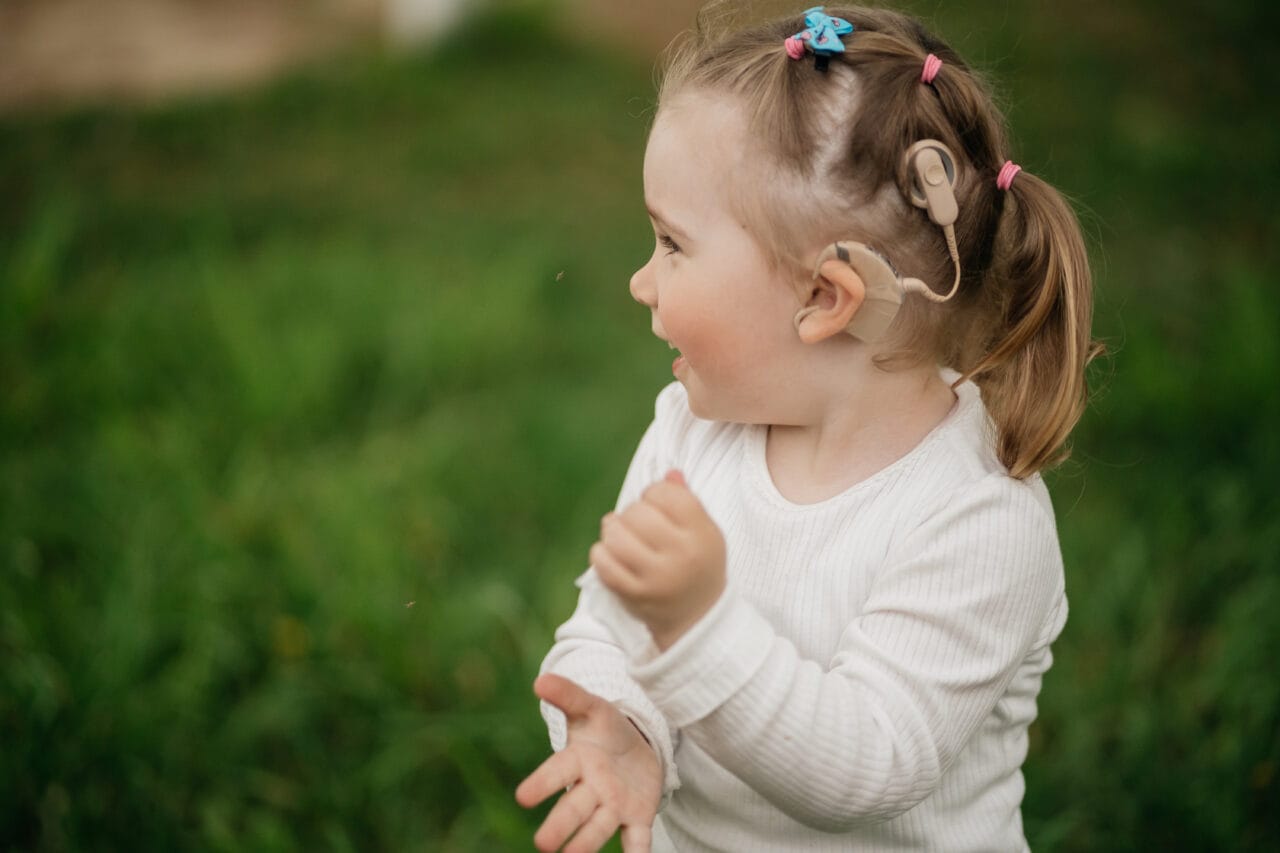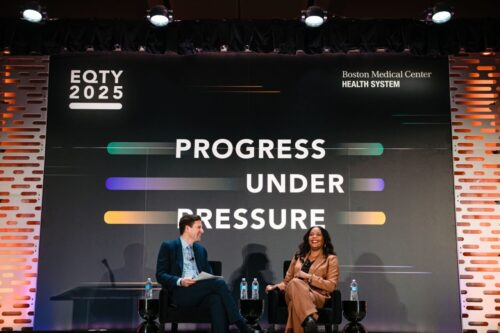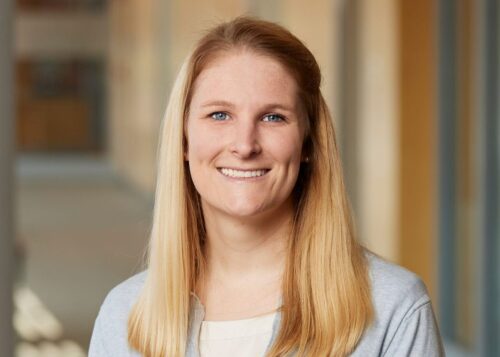New Collaborative Targets Barriers to Care for Deaf and Hard of Hearing Children
October 10, 2024
By Meryl Bailey

Getty Images
Without early access to language-based intervention, deaf and hard of hearing children are at risk of lifelong poor developmental outcomes. An easy-to-access and navigate system, like the new Deaf and Hard of Hearing Collaborative at BMC, becomes crucial.
Deafness and hearing loss is the most common sensory impairment at birth and can significantly impact a child’s lifelong learning and development. To help children reach their full potential, it is imperative to identify hearing loss as early as possible. BMC’s Pediatric Deaf and Hard of Hearing Collaborative is a new initiative designed to do just that.
BMC pediatric providers encounter children who are deaf or hard of hearing from birth and, frequently, those who arrive for care later in childhood. These latter children often have significant delays in communication, come from families who face language barriers, and are not receiving appropriate assistive technology and educational interventions to provide access to language. Couple these challenges with the statistic that, on average, 40% of children who are deaf or hard of hearing have additional developmental diagnoses, finding appropriate support and care can be even more time-consuming and complex.
The Pediatric Deaf and Hard of Hearing Collaborative — co-led by Arielle Spellun, MD, a specialist in Developmental and Behavioral Pediatrics, and Mark Vecchiotti, MD, a surgeon in BMC’s Department of Pediatric Otolaryngology — aims to help families navigate their children’s complex needs and provide them with the necessary tools and resources to support their children’s development. Beyond helping families access assistive technologies, such as hearing aids and cochlear implants, and visual language such as American Sign Language, the team takes a holistic approach to improve patients’ developmental outcomes and overall quality of life.
HealthCity recently interviewed Drs. Spellun and Vecchiotti about the new initiative’s potential to transform support for deaf and hard of hearing children.
HealthCity: How did you conceive the BMC Pediatric Deaf and Hard of Hearing Collaborative? What are the primary obstacles children with hearing loss and their families face that necessitate a more comprehensive, collaborative approach?
Arielle Spellun, MD: When I came to BMC, I immediately started to think about how to collaborate from a clinical, research, and education perspective to support these children’s development. I connected with Dr. Vecchiotti who came to BMC serendipitously at the same time, with the dream of creating a deaf and hard of hearing program in the Department of Pediatric Otolaryngology. We started working with colleagues in Audiology to understand the landscape of what care is available here.
Our patients have multifactorial reasons for their significant language delays. Many kids are newly arrived immigrants from other countries with hearing differences at birth. Parents noticed and became concerned and took journeys — sometimes through multiple countries with multiple languages — to get their children to get to the U.S. for care. Just by the nature of time, their children haven’t had any access to sound or visual communication, such as ASL or other sign languages. They’re first coming to me at ages 7, 8, and 9. It is challenging to ascertain their developmental level and the appropriate educational environment for them.
“Our new collaborative has health equity at its core. Our patients need access to technologies and resources to improve their quality of life. We are willing to devote all the time necessary to get patients what they need.”
Mark vecchiotti, md, surgeon, BMC’s Department of Pediatric Otolaryngology
Through this collaboration, we are conceiving how to maximize resources to care for them and best support them to reach their full potential.
Mark Vecchiotti, MD: It takes many providers to care for all children with hearing loss. From developmental specialists to otolaryngologists to speech pathologists to geneticists, we must better integrate care for these complex patients.
As Dr. Spellun mentioned, our patient population faces many challenges — including financial instability, housing insecurity, and limited English proficiency — that require additional specialized resources. We also need to address all the factors that led to a patient presenting late. Most of the time, this is sorting out what has and has not been done for a patient with respect to finding out why they have hearing loss and what has been done so far to help this. For example, does the patient have hearing aids? Where have they received them? Are they working properly? Does the patient and family understand why they have hearing loss, and why it’s important to address it? What other specialists have they seen? All of this has to be addressed prior to even being able to offer any possible medical or surgical interventions to help with hearing loss.
We were interested in developing a multidisciplinary team and a framework to help fill all these gaps and address all our patients’ needs. In doing so, we can make a huge difference in the care of these kids. It starts with identifying hearing loss, explaining it, and then teaming up with families to begin the journey supporting it.
HC: Who are your partners in this team approach, and how do you coordinate your efforts?
AS: We partner with colleagues in Developmental and Behavioral Pediatrics, Pediatric Otolaryngology, Audiology, Genetics, and Infectious Diseases. Once a patient has all their evaluations, we are all communicating to determine the right educational environment, the candidacy for hearing aids or cochlear implantation (not just based on the imaging but also the resources of the family), the child’s developmental needs, and the likelihood of benefit. At the same time, we are providing education and resources for concomitant sign language access.
We know from bilingualism that we get the best outcomes if we give kids all of the opportunities for visual and auditory language as early as possible. The question we are trying to solve is how you do that when 90% of deaf children are born to hearing parents, and then you add all of the stressors that our families are facing on top of that? These are some of the things that we’re trying to think creatively about. One of the hopes for the program is to involve the community and, specifically, deaf and hard of hearing adult self-advocate and parent-advocate support. I’ve met with different programs that have parents as patient navigators. They are parents of deaf and hard of hearing kids who have navigated the system and figured out how to get what they need, and they come back and work as part of a paid position to be part of the team.
“A big part of the work is creating a support network outside our institution to help these families…. We’re taking a grassroots, community approach to connect all the available resources to best serve these families.”
arielle spellun, md, specialist, developmental and behavioral pediatrics
MV: We’re also creating a database to track all the variables impacting our pediatric patients with hearing loss to identify the best interventions for each individual. The need is great. Currently, we close to 100 patients, and within that population, five of them could benefit from cochlear implants, which is a significant percentage. To put it in perspective, this state’s institutions typically treat only one to five patients who require cochlear implants. Many more can benefit from properly fitting hearing aids.
If we do not adequately support deaf and hard of hearing children, even those with just a mild or moderate hearing loss, and ensure they receive timely interventions that improve their access to language, such as technology and sign languages, they are more likely to have reduced academic, social, and emotional success.
HC: Beyond building a multidisciplinary approach, what excites you about the potential of your new collaborative to support deaf and hard of hearing children?
AS: There’s a big equity piece to our work. Caring for medically complex children, our families must also navigate a healthcare system and a very complicated education system in a new country. It just all builds and builds and builds. A big part of the work is creating a support network outside our institution to help these families.
We are working to develop partnerships with schools that specifically serve deaf and hard of hearing children. We are directly working with the experts in language development of deaf children and deaf researchers to translate their research into the care we are giving and bridging the Wheelock College of Education & Human Development Deaf Center with the BU medical campus through our work.
In addition, the Massachusetts Commission for Deaf and Hard of Hearing has bilingual ASL and English advocates for free who you can refer to who help families navigate IEPs and school process. I’m meeting with all of those different specialists. We’re taking a grassroots, community approach to connect all the available resources to best serve these families.
MV: Our new collaborative has health equity at its core. Our patients need access to technologies and resources to improve their quality of life. We are willing to devote all the time necessary to get patients what they need. For example, we must be creative about building partnerships to set up hearing aid loaner programs. There is not enough money to provide our patients with the equipment they need through the state. The state has a $20,000 budget to give hearing aids to people in need. On average, a set of hearing aids costs $2,000, only providing help for 10 children in the state per year. The need is much greater. I saw 10 pediatric patients who needed hearing aids just this past summer.
BMC caregivers are known for the amazing, progressive, and meaningful things they can accomplish for their patients without many resources. Dr. Spellun and I are motivated to make a difference for deaf and hard of hearing children because it can be done, and the beneficial impact on those children’s lives is profound.
This interview has been edited and condensed for clarity and length.


